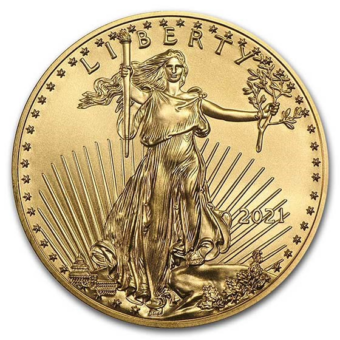EXCERPT: Dive into this week's riveting updates from the gold and silver markets! From shifting U.S. interest rates affecting precious metals, to BRICS' potential challenge to the dollar's dominance, and Jerome Powell's impactful remarks at Jackson Hole—stay informed, ahead, and ready to navigate the glistening world of opportunity. Don't miss out!
The Gold Trail: A Daily Journey Through the Week's Market
Monday - 8.21.23: The gold and silver markets both edged higher on Monday after falling sharply in the previous sessions. The rebound was likely due to a combination of factors, including a weaker U.S. dollar and some safe-haven buying. However, the gains were limited by expectations for higher U.S. interest rates. The markets are likely to remain volatile in the near term.
Tuesday - 8.22.23: Gold and silver raded mixed on Tuesday Gold prices rose 0.2%, supported by a weaker U.S. dollar and some safe-haven buying. The BRICS summit also began on Tuesday in Johannesburg, South Africa. The summit will bring together leaders from Brazil, Russia, India, China, and South Africa to discuss a range of issues, particularly plans for a BRICS trade currency that will likely impact the global economy.
Wednesday - 8.23.23: Gold prices rise slightly, silver targets $25. 61% of middle-class Americans fear outliving retirement savings. Economic developments and global shifts reshape the financial landscape.
Thursday - 8.24.23: Precious metals traded lower today as a stronger U.S. dollar and expectations for higher U.S. interest rates weigh on prices. The dollar index is up 0.2%, while gold is down 0.05% to $1,927.85 per ounce and silver is down 0.01% to $24.36 per ounce.
Friday- 8.25.23: Gold and silver prices remained mixed but largely unmoved as the speech by Federal Reserve Chair Jerome Powell, in which he signaled further rate hikes, received a tepid response from the markets. Meanwhile the dollar index rose to its highest level since early June.
Gold Market Unmoved by Powell's Jackson Hole Remarks
Gold prices remain relatively stable below $1,950 an ounce, showing little response to the most recent statements from Federal Reserve Chair, Jerome Powell. During the annual central bank retreat at Jackson Hole, Wyoming, Powell offered limited insight into the Federal Reserve's future monetary policy. He emphasized the bank's intention to maintain caution as it aims to return inflation to its 2% target. While Powell highlighted the possibility of further interest rate hikes if inflation persists, he stressed the data-driven approach of their monetary policy. Despite these comments, the gold market exhibited minimal reaction, with December gold futures trading unchanged at $1,947.10 an ounce. Analysts' opinions varied, with some finding Powell's remarks consistent with prior statements and others noting a more hawkish emphasis on controlling inflation.
Federal Reserve Signals Potential Further Rate Hikes Amid Inflation Concerns
Federal Reserve Chair Jerome Powell has raised concerns over persistent inflation, emphasizing that it remains "too high" even after a series of 11 interest rate hikes. Addressing the annual retreat in Jackson Hole, Wyoming, Powell stated that the Federal Reserve is prepared to increase rates further if needed to ensure inflation moves sustainably downward towards their 2% objective. Powell, who remarked on similar lines at last year's event, stressed that even though recent data is largely in favor of the Fed, it's premature to declare success in tackling inflation. The central bank's current target interest rate range stands between 5.25% and 5.5%, its highest in over two decades, with the market speculating about the possibility of another rate hike this year. Powell emphasized the need for careful deliberation based on incoming data before making any decisions about future rate adjustments.
Gold's Sheen Unfazed: Investors Stay Bullish Despite Headwinds
Gold remains a preferred investment for many money managers despite the recent challenges it has faced, such as rising real yields, a robust US dollar, and the likelihood of sustained high US rates. A survey involving various investors, ranging from sovereign wealth managers to hedge funds, found that none planned to reduce their gold exposure in the coming year, with over two-thirds expecting gold prices to rise and five anticipating an all-time high. This confidence in gold is driven by ongoing concerns about global geopolitical unrest, macroeconomic uncertainties, continued buying by central banks, and solid retail demand in emerging markets. Moreover, the decoupling of equities and bonds has further bolstered gold's appeal as a diversification tool. However, the immediate future for gold still remains uncertain, with many keenly awaiting comments on interest rates from the upcoming Jackson Hole gathering of central bankers.
Silver's Resurgence: A Reversal in Bearish Trends?
Silver has experienced a surge recently, witnessing a rally of 7.95% over the past week, effectively offsetting its losses from the preceding month. This turnaround comes after net speculative positions in silver futures plunged by 88% up to 15th August 2023, now resting a standard deviation below its 5-year average. This suggests a significant cover-up of short positions over the past week. From a technical standpoint, silver's price bounce from its local low of US$22.35/oz to US$24.27/oz, an 8.6% increase, aligns with Fibonacci-implied support levels. Significantly, it crossed the 61.8% Fibonacci retracement resistance, which experts view as a bullish signal. On the inventory side, the Silver inventory in the London Bullion Market Association vaults, which witnessed a sharp decline of 28% in 2022, has seen a 3% uptick up to July 2023. Moreover, the drastic decline in silver holdings in exchange traded commodities (ETCs) has subsided in 2023, suggesting a more balanced outlook among investors.
Can U.S. Debt Crisis Spark a Long-Term Gold Rally?
The gold market's current challenges, driven by the Federal Reserve's hawkish monetary policies, could soon shift, as mounting U.S. debt may lead the central bank to become the primary buyer of Treasuries, sparking a significant rally for gold. This sentiment comes on the heels of a Fitch Ratings downgrade of U.S. long-term debt earlier this month. While this initially caused minimal market upheaval, it has since spotlighted the escalating U.S. deficit. BCA Research, a Montreal-based firm, emphasizes gold's allure as a buffer against probable U.S. dollar depreciation given the expanding U.S. debt-to-GDP ratio. They note that as the debt level approaches 97% of GDP, fiscal dominance could become unavoidable, resulting in escalating inflation. BCA's projections suggest the U.S. could match its highest debt-to-GDP ratio from 1946 by 2028, potentially reaching 110% by 2030 if spending trends persist. Amidst these predictions, BCA remains optimistic about gold, anticipating prices nearing $2,000 an ounce by year-end.
BRICS Expansion: A Push for De-dollarization Amid Growing Membership
The conclusion of the 15th BRICS summit was marked by the announcement of six new member countries and a renewed discussion about introducing a BRICS trade currency to challenge the U.S. dollar's dominance. Brazilian President Luiz Inacio Lula da Silva championed the proposal for a common currency to enhance transaction conditions within the BRICS nations and decrease their vulnerabilities. He also criticized the current global financial structure, asserting that it is prejudiced against developing nations. As Russia assumes the BRICS chairmanship with the next summit scheduled in Kazan in October 2024, President Vladimir Putin emphasized de-dollarization. Putin, who has previously advocated for moving away from the dollar due to U.S.-led sanctions against Russia, highlighted that BRICS' trade in dollars has decreased, accounting for only 28.7% of transactions last year. However, the inclusion of six new members might make achieving a consensus on a common currency more challenging, as differing views among member states could pose obstacles to unanimity.
Silver and Gold Rally in Response to US and EU Yield Retracements
The technical outlook for silver and gold has become increasingly optimistic, with analysts at ActionForex highlighting a promising surge in the silver market that has simultaneously lifted gold prices. This bullish momentum is believed to be a direct reaction to the recent decline in US and EU treasury yields, which faltered due to underwhelming PMI data. Experts speculate that major central banks might be nearing the end of their tightening phase. While many await comments from Federal Reserve Chair Jerome Powell, insights from other key central bankers are also anticipated to influence market direction. The current silver trend has surpassed the 55-day exponential moving average (EMA), suggesting potential further increases. In contrast, gold is perceived to have established a short-term base, with projections indicating a rise towards its own 55-day EMA.
Next Week’s Key Events
MONDAY, AUG. 28
On this day, there are no economic reports scheduled for release.
TUESDAY, AUG. 29
Three major reports are slated for this day:
9:00 am - S&P Case-Shiller Home Price Index for June: This index measures the change in the value of residential real estate in 20 metropolitan regions of the U.S. A rise in home prices can be indicative of a stronger economy and potentially higher inflation, which might boost gold as an inflation hedge. However, a decline could suggest economic softness, which can be bearish for silver due to reduced industrial demand.
10:00 am - JOLTS Job Openings for July and Consumer Confidence for August: JOLTS provides data on job vacancies, which is a measure of labor market strength. Strong job openings can put downward pressure on precious metals, as it indicates economic strength. Consumer Confidence gauges the level of consumer optimism about the economy. High consumer confidence may diminish the appeal of safe-haven assets like gold and silver. Conversely, low confidence might boost their appeal.
WEDNESDAY, AUG. 30
A trio of reports are on the docket:
8:15 am - ADP Non-Farm Employment for August: This is a precursor to the official jobs report and indicates the number of jobs added outside the farming sector. A strong number could be bearish for gold and silver as it might signal economic health.
8:30 am - GDP (revision) for Q2: The GDP report measures the health of the economy. A higher GDP can signify economic strength, potentially pressuring precious metals downward. A weak GDP might provide a boost to gold and silver.
10:00 am - Pending Home Sales for July: This provides insights into future housing market activity. A rise might suggest economic strength, potentially reducing the allure of precious metals. A decline can do the opposite.
THURSDAY, AUG. 31
The focus will be on:
8:30 am - Initial Jobless Claims for Aug. 26: A measure of unemployment benefits claims. Rising claims can be bullish for gold and silver as they suggest economic softness, while declining claims might reduce their appeal.
8:30 am - PCE Index for July: This is the Federal Reserve's preferred measure of inflation. Rising inflation can make gold more attractive as a store of value. Silver, often viewed in part as an industrial metal, might not get as much of a boost unless inflationary pressures increase industrial demand.
FRIDAY, SEPT. 1
The day features:
8:30 am - U.S. Jobs Report (Employment Situation) for August: This is a key indicator of economic health. Strong job growth can depress gold and silver prices, as it may signal a strong economy and reduce the need for safe-haven assets.
10:00 am - ISM Manufacturing for August: Reflects the health of the manufacturing sector. A strong report might pressure silver due to increased industrial demand, while a weak one can do the opposite.
10:00 am - Construction Spending for July: A measure of the amount spent on construction. Higher spending can be bearish for silver due to increased industrial use, while lower spending can be bullish.
In summary, the gold and silver markets can be influenced by various economic indicators, reflecting the overall health of the economy, consumer sentiment, inflation, and sector-specific activities. These markets will be keenly observing the reports to determine their next moves.





















